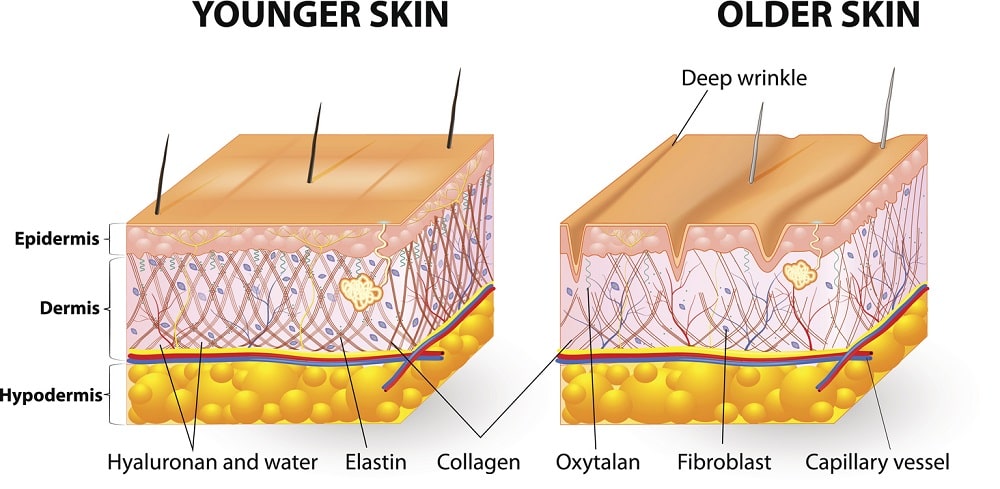Table of Contents
The skin is our body’s largest organ, consisting of three layers, and requires an abundant supply of new cells every day to keep it looking healthy. We lose roughly 30,000 to 40,000 dead skin cells each day. The skin is also a complicated organ affected by aging, hormones, outside factors, lifestyle habits, health, food, and many other issues that can also lead to wrinkles and sagging skin. It is natural to assume that aging is the leading cause of wrinkles, sagging, age spots, thinning, and dryness. However, aging itself should not be the focus of why the skin changes. That is what we will examine in this report that sheds light on why the skin changes and how to treat it.
We often think of our skin in terms of its appearance – how it keeps us looking young and healthy. That is not the primary function of the skin. It is a protective barrier against the outside world – keeping invading microorganisms from entering the body. The skin is crucial to the immune system, and it also helps regulate body temperature. As we age, and the layers of the skin become thinner, the functions of the skin suffer. Its role in gathering sensory information from the environment is also in jeopardy. By protecting the skin against thinning, wrinkles, and sagging, we can help it, and our whole body, function (and look) better.
In this review, we look at the following areas:
- What Makes Up the Three Layers of the Skin
- How the Skin Changes with Aging
- Common Causes of Wrinkles and Sagging Skin
- How Hormones Affect the Skin
- Hormonal Causes of Sagging Skin and Wrinkles
- How to Protect the Skin
Dermis, Epidermis, and Hypodermis: Three Layers of the Skin
The skin is part of the integumentary system, which also consists of hair, exocrine glands, and nails. Many people notice that at the same time that they experience wrinkles and sagging skin, their nails become brittle, and their hair starts to thin and fall out faster. Part of the reason for this is the hormonal changes we will discuss further down the page.
First, however, we want to shed light on the three layers of the skin and their functions:
Epidermis: The Outermost or Superficial Layer of the Skin
The thickness of the outer layer of the skin, the epidermis, changes according to the location. The epidermis is thinnest over the eyelids and thickest at the soles of the feet and the palms of the hands. Over most of the body, the 40 to 5o stacked rows of squamous epithelial cells measure only a tenth of a millimeter in thickness. Here, we find the following types of cells:
- Keratinocytes: making up about 90% of the epidermis, keratinocytes produce and store the keratin protein that makes the skin water-resistant.
- Melanocytes: accounting for 8% of the epidermis, melanocytes provide the melanin pigment that protects the skin from ultraviolet radiation. As a side note, melanocytes also give the color to growing hair shafts as they push their way up through the skin.
- Langerhans cells: approximately 1% of epidermal cells are here to fight the invading pathogens trying to enter the body.
- Merkel cells: the remaining 1% of epidermal cells connect to nerve endings to sense touch.
The epidermis consists of five layers:
- Stratum corneum: consisting of 15 to 30 layers made of dead keratinocytes at the top of the skin, protecting underlying layers against microbial penetration
- Stratum lucidum: found beneath the stratum lucidum on the soles and the palms
- Stratum granulosum: the layer of keratinocytes on their way to the stratum corneum
- Stratum spinosum: the thickest layer of the epidermis containing keratinocytes and Langerhans cells
- Stratum basale (stratum germinativum): the bottom layer where column-shaped basal cells (keratinocytes) divide and push cells upwards towards the top, causing them to flatten, Merkel cells and melanocytes are also here
The cells in the stratum basale bind to the dermis below with intertwining collagen fibers.
Dermis: The Deep Layer Under the Epidermis
Consisting of connective tissue, blood vessels, nerves, hair follicles, oil and sweat glands, and lymph vessels, the dermis contains two layers composed of collagen and elastin fibers:
- Papillary layer: here, in the thin, upper layer of the dermis, the elastin and collagen fibers form a loose mesh. Fibroblasts found here are cells that enable epidermal proliferation and differentiation. A small supply of adipocytes (fat cells) can also be found here. The blood vessels here provide a steady supply of oxygen and nutrients for the epidermal cells.
- Reticular layer: thicker than the papillary layer above, the reticular layer consists of collagen fibers that provide the structure and strength to the skin, as well as binding water to hydrate the skin. Also found here are the elastin fibers crucial for elasticity and skin movement.
Hypodermis: The Deepest Layer of the Skin
Connecting the skin to the underlying bones and muscles, this subcutaneous layer consists of loose connective tissue containing collagen and elastin fibers that allow the skin to stretch and move separately from the structures below. The hypodermis is also home to fatty adipose tissue that stores triglycerides (energy) and helps insulate the body by trapping the heat that the muscles produce. The subcutaneous fat stored in the hypodermis is also that which most people want to lose any excess buildup.
When people complain about sagging face skin, wrinkles, and dry, thin skin on arms and legs, it is often due to declining levels of collagen. We will discuss this topic more in the next section on skin and aging.
Skin Condition with Aging
Wrinkles and sagging skin are often the most visible signs of aging in the adult body. The loss of collagen and elastin, along with a decrease in cellular regeneration, means less new skin cells to replace the ones that die off each day.
Why is my skin sagging as I age?
The skin is the body’s outside defense against the world, which also puts it at the mercy of the sun’s ultraviolet light, harsh weather, diet, lifestyle habits, and genetics. We will discuss what causes wrinkles and sagging skin in the next section.
The changes that occur to the skin with aging include:
- Thinning of the skin and an increased risk of damage (tears, injuries)
- Skin texture and feel becomes rougher
- Loss of elastin causing the skin to become loose and sag
- Decreased collagen production which takes away the plumpness of the skin
- With thinning, the skin appears more transparent
- Fat loss below the facial skin can cause increased eye wrinkles, looseness, and a skeletal appearance
- Increased bruising due to thinning of the blood vessel walls
Common Causes of Sagging Skin and Wrinkles
Aging, wrinkles, and sagging skin – yes, they may seem to go hand in hand, but it is time to look at the most common causes of these changes.
What causes wrinkles and sagging skin?
Here are the most common causes of under-eye wrinkles, sagging skin, forehead wrinkles, neck wrinkles, and other age-related changes to the skin:
- Sun exposure – ultraviolet (UV) light damages the elastin fibers that maintain the skin’s elasticity. As elastin breaks down, the skin stretches and sags, unable to snap back after the stretching. Bruising risk increases as the skin no longer offers the same protection. Sunscreen, wearing head covering, and staying out of the sun can delay these changes.
- Sleep – how you sleep, and your head’s position on the pillow can result in creases near the temples on the side of the forehead, as well as on the cheeks. Back sleeping helps decrease this effect.
- Smoking – those who smoke tend to develop wrinkles faster, especially around the mouth, than non-smokers.
- Climate – winter weather tends to dry out the skin.
- Medications – certain medicines can make the skin feel itchy or dry.
- Oil glands – with aging comes a reduction in oil glands, which can increase skin dryness.
- Hormonal changes – many hormones contribute to skin health. We will begin our discussion of hormones and the skin in the next section.
- Environmental pollutants – along with cigarette smoke, smog, and other environmental pollutants in the air can affect the skin.
- Alcohol – excessive alcohol use can make the skin age before its time.
- Weight gain and loss – being overweight can damage the elastin and collagen fibers in the skin. Then with weight loss, the skin no longer has the ability to snap back due to the overstretching of the fibers. That is why people who lose a significant amount of weight often have loose, sagging skin.
- Food – the food you put in the body can help or harm your health and appearance. Foods that accelerate skin aging include:
- Fried foods
- Sugar
- Refined carbohydrates (white bread, baked goods)
- Margarine
- Soda
- Processed meats
- Rice cakes
For many people who enjoy the occasional facial, why is my skin sagging so fast if I am taking care of it, is a common question. There is more to skincare than what you put on the outside. It is just as important to look at all these other factors when discussing the possible causes of wrinkles and sagging skin.
How Hormones Affect Our Skin
Hormones are the body’s messengers, regulating nearly every function. Critical to the skin, some hormones outright promote cellular reproduction. If the body cannot manufacture enough new cells quickly enough to replace the ones that die off, there will be shrinkage and thinning of the corresponding tissues and organs. With roughly 30,000 to 40,000 skin cells dying every day, that can be problematic for the skin.
As we look at hormones, wrinkles, and sagging skin, we find many of these vital chemical messengers that can alter our skin’s appearance and structure. We will discuss each one in detail in the next section.
Hormonal balance is crucial to the body, not just for the skin’s sake, but for every other function, as well. Skin issues are often a sign of underlying problems with the body’s hormones and can alert you to other issues that could be present.
Hormonal imbalance can take the form of too little or too much of any one or more hormones. Problems that can occur when hormone levels impact the skin include:
- Wrinkles
- Sagging
- Thinning
- Age spots
- Acne
- Cellulite
- Rash
- Hives
- Roseola
- Loss of elastin and collagen
- Sallow appearance
- Drooping eyelids
- Oiliness
- Dryness
- Slow wound healing
Hormonal Causes of Sagging Skin and Wrinkles
We often hear about low estrogen and menopause and increased skin aging. However, there is far more to wrinkles and sagging skin than changes in estrogen production. In the list below, we look at the hormones that most commonly affect the appearance and structure of the skin:
- Estrogen:
Estrogen is crucial for skin hydration and collagen production. Declining estrogen levels result in dryness and loss of elasticity. Fine lines become deeper crevices, and eyelids may start to droop due to decreased blood flow. Estrogen loss can lead to thinning skin.
Some women have higher levels of estrogen, which can cause hyperpigmentation of the skin.
- Testosterone:
The sebum-production glands rely on testosterone for the production of the oils that maintain skin luster. However, too much testosterone can lead to acne at any age. Testosterone is also crucial for maintaining collagen and elastin production. Low testosterone can lead to dry skin.
- Progesterone:
Progesterone also plays a roll in skin hydration and elasticity, and its decline can result in dull-looking skin. Increasing progesterone levels can help improve circulation and skin elasticity. Another fact about progesterone is that it helps estrogen function better in the body. With age, the balance between progesterone, testosterone, and estrogen can change, causing a condition called estrogen dominance that can lead to many problems. Also – do not mistake progesterone for synthetic progestin, which can cause many issues.
- Thyroid hormones:
An underactive thyroid that does not produce enough thyroid hormone can cause the skin to become coarse and dry. Sweat ability might also decline. An overactive thyroid that secretes too much thyroid hormone can lead to sweaty, flushed skin.
- Growth hormone:
One of the leading chemical messengers that interfere with skin appearance is growth hormone. GH, along with its mediator, insulin growth factor 1 (IGF-1), promotes the production of new cells. These cells help increase keratinocytes, collagen, elastin, and other skin cells to help with repair and prevention of wrinkles and sagging.
- Cortisol:
High cortisol (stress hormone) levels can increase the production of sebum, which can trigger acne, as well as promote inflammation that can worsen skin irritations, including eczema, vitiligo, and rosacea. Cortisol also increases collagen loss, resulting in thinner, sagging skin.
- Insulin:
Elevated insulin levels can accelerate the effects of skin wrinkling. Many times, increased insulin is due to poor dietary choices. Growth hormone imbalance can also alter insulin sensitivity and increase insulin levels.
How to Prevent Sagging Skin and Wrinkles
The prevention of wrinkles and sagging skin is one of the leading money-making industries, with Americans spending more than $17 billion a year on spa services alone, not to mention all the many facial and skin products on the market today. However, those are not the only ways to prevent or reduce changes in skin texture and appearance.
The best option is to always get to the root of the problem. A person who spends hours out in the sun every day would be wasting his or her money on products as the damage to the skin is permanent. The best option is to stay out of the sun. Drinking plenty of water (not alcohol, soda, or caffeine) can help hydrate the skin.
Similar benefits can come from changing poor dietary or lifestyle habits, sleeping on a satin pillowcase or one’s back, and reducing stress. Of course, exercise, specifically weight-bearing exercises, can help improve muscle tone, which can make the skin appear firmer. Facial exercises can help tone neck and facial muscles to reduce the appearance of sagging skin.
Retinol-containing topical treatments may help improve eye and facial skin elasticity. Some prescription products may even help increase collagen production.
One of the best options is to contact a hormone specialist for comprehensive blood analysis to measure hormone levels. If a hormonal imbalance is present, its correction through hormone replacement therapy may offer the most significant benefits to reduce the appearance of wrinkles and sagging skin.
How Can We Help?
Hormonal imbalance is a leading cause of skin changes as people age. Wrinkles and sagging skin can happen to anyone – male or female. Women are just as likely to suffer from low testosterone as men. Both genders begin to experience a decline in growth hormone production before age thirty, as well.
High or low hormone levels can cause more than just wrinkles and sagging skin. They can lead to increased risks of developing conditions such as:
- Cardiovascular disease
- Obesity
- Type 2 diabetes
- Dementia
- Osteoporosis
Getting the right type of treatment for a hormonal imbalance is crucial. Our doctors are hormone specialists who understand how best to balance the body’s delicate hormone levels. They know how testosterone therapy can alter estrogen and growth hormone levels, and how GH can improve testosterone, and, subsequently, estrogen levels. The right, personalized treatment can work wonders for your appearance and well-being.
Some of the hormone treatments that can help improve the appearance of the skin include:
- Human growth hormone therapy: helps lower cortisol and increase testosterone levels. HGH treatment improves cell regeneration, which is crucial for collagen and elastin production.
- Testosterone therapy: not only benefits collagen and elastin production but also maintains the sebum glands. Increasing testosterone also provides more growth hormone and estrogen to the body.
- Progesterone therapy: improves hydration, circulation, and skin elasticity, working with estrogen to support healthy skin.
- Estrogen therapy: beneficial for skin elasticity, hydration, and collagen production.
Our hormone clinic provides free, confidential consultations by phone to men and women wanting more information about hormonal imbalance and treatment. If you are concerned over wrinkles and sagging skin, or any other issues associated with aging and declining hormone levels, contact our clinic today.





No Comments
Sorry, the comment form is closed at this time.